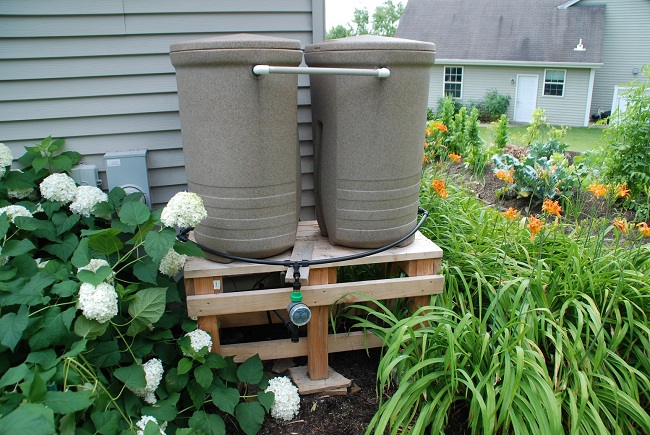
Put rainwater to use in your landscape with the help of rain barrels. This centuries old technique allows you to capture rainfall to use for watering plants, gardens, and containers.
Always start with a call to your local municipality. Some have restrictions on water harvesting, but most encourage this practice, and some even offer rebates or rain barrels at a discounted rate.
Purchase a rain barrel or make your own from a large, recycled food grade container. In either case, there are some features to consider when purchasing, creating, and adding a rain barrel to your landscape.
Make sure the top is covered to keep out bugs and debris. Some come equipped with a solid lid with an opening just big enough to accommodate the downspout. Others use a screen to keep out debris, while letting in the rain. Look for one with the spigot near the base of the barrel so water does not stagnate in the bottom. Use the spigot to fill watering cans or attach a hose for watering.
Include an overflow outlet near the top of the barrel to direct excess water away from the house or for connecting adjacent barrels. A downspout diverter is another way to manage rain barrel overflows. When the rain barrels are full, this device diverts the water back to the downspout where it is carried away from your home’s foundation.
Elevate your rain barrel on cement blocks, decorative stands, or similar supports. This provides easier access to the spigot for filling containers and speeds water flow with the help of gravity. A water pump will boost water pressure for a nice steady flow of water.
Dress up your container with a bit of paint suited for outdoor use on plastic surfaces. And don’t worry if you are not an artist, you can hide your rain barrels with some decorative screens or plantings or upright shrubs, perennials, or ornamental grasses. Just make sure you have easy access to the spout for retrieving water.
Start your conversion to rain barrels one downspout at a time. You can capture as much as 623 gallons of water from 1,000 square feet of roof in a one-inch rainfall. This can be a lot to manage when you are first adjusting to this new strategy. Disconnecting one downspout at a time allows you to successfully match the use of rain barrels and other rain harvesting techniques to your gardening style and schedule.
Melinda Myers has written more than 20 gardening books, including Small Space Gardening. She hosts the “How to Grow Anything” DVD series and the Melinda’s Garden Moment TV & radio segments. Her website is MelindaMyers.com.
Photo courtesy of Melinda Myers.
Related Articles & Free Vermont Maturity Subscription

Curious About CBD? Here’s What it Can and Cannot Do for You
How to Identify and Eliminate Fungus Gnats on Houseplants






Comment here